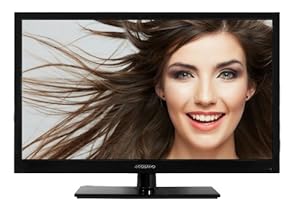oCOSMO 32-Inch 720p 60Hz LED HDTV
List Price: $299.99Price: $179.99 & FREE Shipping. Details
You Save: $120.00 (40%)
Low Price Guarantee
In Stock.
Ships from and sold by Amazon.com.
- Sleek & Slim 32-Inch LED 720P HDTV
- 3 x HDMI Port, MHL Port, USB Port
- ATSC/NTSC/Clear QAM
- 60 Hz Refresh Rate
- Wall mountable 200 x 200 VESA Standard
Pictures in HDTV look sharper and clearer than that of regular TVs. The quality of the high definition broadcast signal is such that the images you see life like images. This incredible picture quality makes you feel as if you are on the soccer field, when you are watching a soccer match. If you are watching a movie on your HDTV, you would feel like you are sitting in the front seat of a movie theatre.
Wide Screen
The hallmark of a HDTV is its rectangular wide screen and the high resolution of display. The way the picture is transmitted and displayed on the screen depends upon its aspect ratio. The aspect ratio is the width to height ratio of a TV monitor or its program format. In comparison to the 4:3 aspect ratio of the old analog TV, which has a square appearance, the wide screen of HDTV has a 16:9 viewing aspect ratio. This makes the real difference that why the later leads to a better visual and acoustic enjoyment of watching television.
Why Wide Screen Display Is Better?
The simple reason is that the wider view is closer to the human vision. Our vision is optimized within a 30-degree field, and beyond 30-degree there is no visible benefit. The central area of this field provides us the best view, but the peripheral vision is better at detecting motion. Where the 4:3 aspect ratio of analog television allows us only a 10-degree field of vision, HDTV allows us a complete 30-degree.
Note: Do not confuse the aspect ratio with the screen size. The screen size is the diagonal measurement. HDTV comes in multiple sizes, but the aspect ratio is always 16:9.
Resolution
HDTV comes in two different resolutions – 1080i and 720p. The ‘i’ in 1080i means interlaced, and the ‘p’ in 720p means progressive. In both the resolutions, every second consists of 60 frames of video.
Progressive Resolution
Progressive resolution puts 60 full frames on the screen every second. The 720p video resolution is 1280 X 720 pixels, which gives 921,600 total pixels.
Interlaced Resolution
Unlike progressive resolution, interlaced resolution puts half and half, 30 frames of odd lines and 30 frames of even lines, on the screen every second. Some people complain that it causes flickers on screen. However, the fact is you see the complete image on your TV screen two times more often, which results in smoother motion, and the flickers, if at all they exist are not visible. The 1080i video resolution is 1920 X 1080, which gives whopping 2,073,000 pixels.
What is pixel, and how does it make a difference?
A TV screen is made up of small picture elements known as pixels. Each pixel constitutes three closely spaced dot colors – red, blue and green. Combined together on the TV’s phosphor screen, and when viewed from a distance, the colors are seen as one. The pixels in the analog system are slightly taller than their width while in HDTV they are 4.5 times smaller, spaced closer, and square in shape. This enables HDTV to display 4.5 times more detail than analog television.
Which resolution is better?
It is nothing like which one is better. Both 720p and 1080i have their own qualities. Though not quite visible but technically the displayed images on 1080i slightly flickers. This causes a psychological difference, and some people like the slightly more ‘stable’ picture of 720p, while others prefer the whopping resolution of 1080i. If you find it difficult to decide, our only suggestion is that you run down to your local TV store and see for yourself. After all, the beauty is in the eyes of the beholder.
Different TV display technologies
There are three different formats, which offer the HD technology.
CRT (Cathode Ray Tube) – This paints the images onto the screen. The style is perfect in any lighting condition and from every angle.
Plasma Display – It has an ultra-thin design, and it displays digital images at a high resolution. The major drawback is that it is costly and picture quality is affected, as it does not display black color efficiently. Moreover, many plasma displays do not display HDTV resolution.
LCD (Liquid Crystal Display) – It uses two different polarized, transparent panel to house a liquid in the middle. It is thin in design but there are certain size limitations. Picture quality is good for static displays only. When it comes to display images in motion, LCD does not perform well. Moreover, many LCD displays are not HDTV capable.



